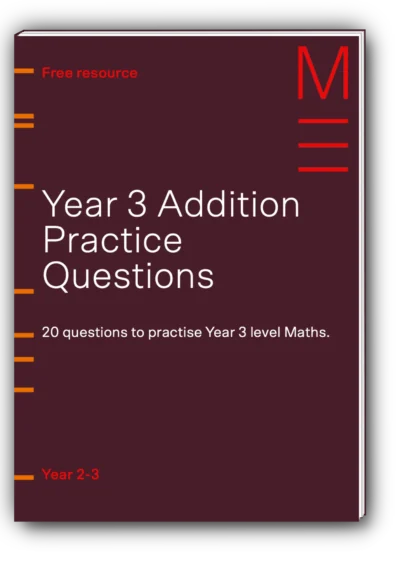Welcome to Matrix Education
To ensure we are showing you the most relevant content, please select your location below.
Select a year to see courses
Learn online or on-campus during the term or school holidays
Learn online or on-campus during the term or school holidays
Learn online or on-campus during the term or school holidays
Learn online or on-campus during the term or school holidays
Learn online or on-campus during the term or school holidays
Learn online or on-campus during the term or school holidays
Learn online or on-campus during the term or school holidays
Learn online or on-campus during the term or school holidays
Learn online or on-campus during the term or school holidays
Learn online or on-campus during the term or school holidays
Select a year to see available courses
Science guides to help you get ahead
Science guides to help you get ahead
Build your child's confidence in Maths with these Year 3 addition practice questions and worksheet. Support your child's learning at home!

Join 75,893 students who already have a head start.
"*" indicates required fields
Related courses

Join 8000+ students each term who already have a head start on their school academic journey.
Is your child ready for Year 3 Maths? Strong numeracy skills are important for your child’s learning, from recognising patterns to solving everyday problems. And it all starts with addition practice!
In this article, we’ll walk you through the key stages of early numeracy, why Year 3 Maths matters, and share a free Year 3 addition practice worksheet to help your child stay on track.
Table of contents:
Children develop numeracy in stages. Understanding where your child is at can help you support them effectively. Here are the 4 major stages of learning early numeracy concepts:
For a more elaborate page summary, read this sheet.
By Year 3, students should be able to apply mental Maths strategies like:
These skills form the bedrock for harder topics like multiplication and problem-solving in upper primary and high school.
When these foundations aren’t strong, students can quickly lose confidence. This often leads to frustration or disengagement in Years 5 and 6, and those gaps tend to grow in high school.
Less than 1 in 5 students who fall behind in Year 3 catch up later. Most student with early low performance risk struggle to keep up with their peers throughout school.
That’s why regular practice at the early stages is so important. Structured Year 3 addition worksheets (like the one below) can help your child build the confidence they need to keep up.
If you’d like to see our multiplication worksheet, you can find it here!
Fear not! The Maths team at Matrix has put together these 20 Year 3 addition practice questions. These should give you a feel for where your child’s numerical ability should be.
If your child is unable to solve the questions, we’ve provided some strategies at the end that you can implement during everyday activities. Here’s a sneak peek at two sample questions from our free downloadable Year 3 Maths worksheet.
These align with NESA’s current Mathematics syllabus and can help prepare for the Year 3 NAPLAN. If you want to learn more about NAPLAN and how to prepare for it, read our article here.
Remember, no calculators allowed. Good luck!
After school, Charlie asked his mum if they could buy some chocolate. They walked 243 steps to the zebra crossing. Then they walked 387 more steps to the supermarket. How many steps did they walk altogether?
The correct answer is 630 steps.
Charlie and his mother initially walk 243 steps to the zebra crossing, before walking an additional 387 steps to reach the supermarket. If we want to find out how many steps were taken in total, we’d add up all the steps taken on the journey:
\(total = 243 + 387 = 630\)So the answer must be 630.
Tom and Greg sat by the window to count cars for 3 hours. In the first 30 minutes, they saw 135 cars. In the next 30 minutes, they saw 29 more cars than before. Then, in the second hour, they saw 23 more cars than in the first hour. In the third hour, they saw 98 cars. How many cars did Tom and Greg see altogether?
The correct answer is 719 cars.
The best way to solve problems like these is to break them down into smaller parts. Let’s look. at what’s happening in each hour.
The first hour is broken up into 30-minute halves. If we recall from the article, “In the first 30 minutes, Tom and Greg see 135 cars pass by“. So, as far as the first hour goes, we just need to figure out how many cars were seen in the second 30 minutes. Again, referring back to the information in the question, we know that “Tom and Greg see 29 more cars pass by compared to the first 30 minutes”
We’ll need to extract information from the question to deduce how many cars Tom and Greg see in the first hour. Taking a quick look, we can see that equates to 135 cars.
The examples above come from our Year 3 Maths worksheet, available for download below. It’s a great way to assess and support your child’s addition skills at home.
Download this free worksheet to help your child build strong Maths skills. Fill out your details below to get this resource emailed to you. "*" indicates required fields
20 fun and engaging Year 3 addition questions!

20 fun and engaging Year 3 addition questions!
If your child is struggling with addition, practising in everyday moments can make a big difference. Here are some easy ways to reinforce number sense outside of the classroom:
Count together aloud: Whether you’re climbing stairs, setting the table, or packing lunchboxes, count items together and talk through the numbers.
Use real-world problems: Ask questions like “If we have 3 apples and buy 4 more, how many do we have now?” at the shops or during meal prep. (Want more ideas like this? Try our Fun Maths Activities for Kids.)
Play Maths games: Card games, board games, or even dice games can be great for practising addition and subtraction in a fun, low-pressure way.
Talk through mental strategies: When solving a problem together, model your thinking out loud — “I know 7 + 3 makes 10, so 7 + 4 must be 11.”
Encourage estimation: Ask your child to guess how many items are in a jar or how long something will take, then count or time it together to check. STart with single digit numbers then continue practising multi-digit addition.
Small, consistent interactions with numbers help normalise maths and boost your child’s confidence.
If your child is not yet in Year 3, it’s never too early to start. Here are 3 simples ways to boost your child’s Maths skills before Year 3.
Here’s an important reminder from Michelle Barrington (one of Australia’s leading school parenting resources):
“The goal at this stage of numeracy development is for children to feel confident in their personal knowledge of Maths. They need to feel confident in being able to apply strategies to solve problems as well as being confident in what they have been taught, so that they can make connections between old information and new skills.”
If your child needs support beyond worksheets, structured tutoring can help. Matrix Year 3 Maths courses are designed to help your child build confidence and master key skills.
Help boost your child's skills in English and Maths
Expert teachers and high-quality resources trusted by 8,000+ families each term. Book a free trial lesson.
Written by Jill Tengco
Jill is the Content Marketing Specialist at Matrix Education. She holds a Bachelor of Media (Communication and Journalism) from the University of New South Wales and is passionate about creating educational content that helps students succeed.© Matrix Education and www.matrix.edu.au, 2025. Unauthorised use and/or duplication of this material without express and written permission from this site’s author and/or owner is strictly prohibited. Excerpts and links may be used, provided that full and clear credit is given to Matrix Education and www.matrix.edu.au with appropriate and specific direction to the original content.